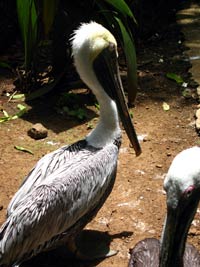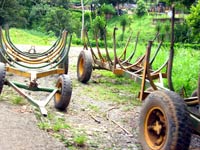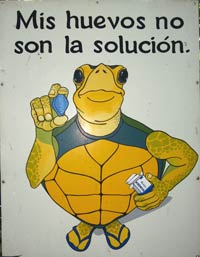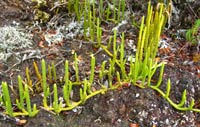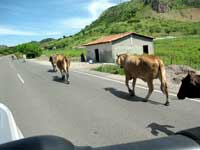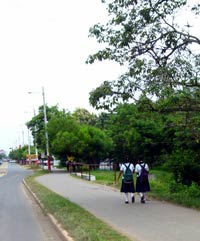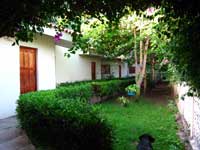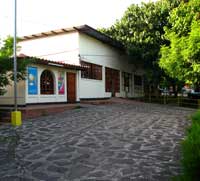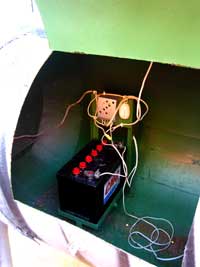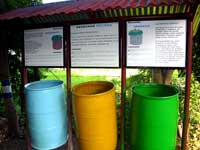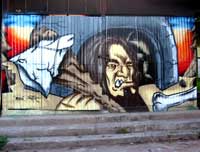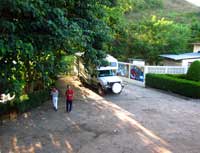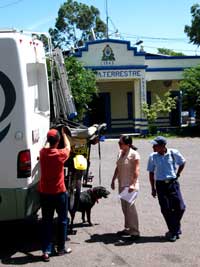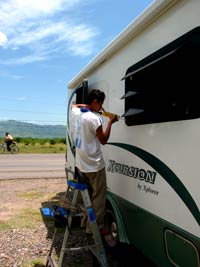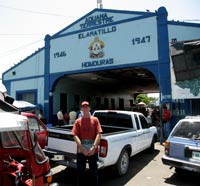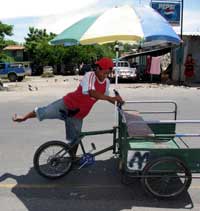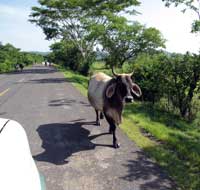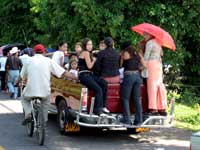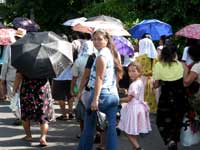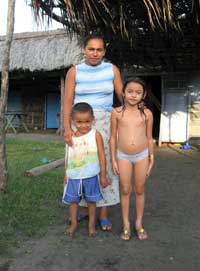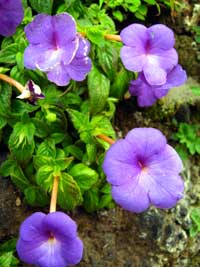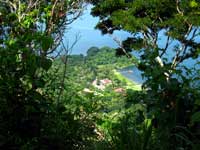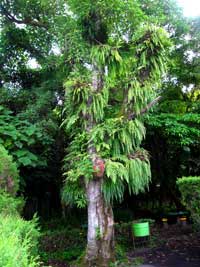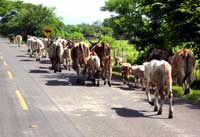

|
 |
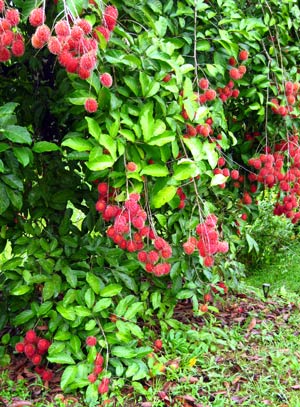 |
|---|
Kathleen and Ziggy had a spirited walk/run up a trail from the highest point on the highway, near the Cerro de Chirripo, over 12500 feet high. They (or at least she) wanted to view the exquisite tundra plants that grow in these high regions with so few nutrients. It was raining, actually pouring, but with protection from a Gortex raincoat and hiking boots and a dog that adores water she found the wildness of the place exhilarating, that is until she began to worry about her camera getting wet and ran back to Rus who was reading in the rig.
Back Through Nicaragua...... a narrow escape
In Nicaragua, driving through Diriamba, we passed a hardware store with some carved wooden shovels for sale. Rus was interested. Doubling back through cramped side streets to where he'd seen them he side-swiped a parked delivery truck, breaking its mirror and one of our side coach window panels. Unfortunately the driver wasn't the owner of the truck, so he couldn't accept our offer of payment to avoid the police getting involved. A crowd quickly gathered, everyone offering opinions as to who was at fault (Rus, unanimously) and what would be a reasonable compensation to the victim (it was running higher by the minute).
This was without a doubt Kathleen's most stressful moment of the entire trip. The crowd was growing larger by the minute, men yelling rapidly in Spanish, demanding our attention, others shaving their fingers at us without a hint of compassion. One guy shouted that we'd have to pay $100 US and had better do it quick before the cops came. Realizing that the coach and cab doors weren't locked Kathleen didn't dare leave the rig to join Rus. A motorcycle cop soon arrived, made his way through the crowd, and spoke with the driver of the truck, who contacted his company. The driver was fair and settled on $45 US as a reasonable value for the mirror, which we were glad to pay.
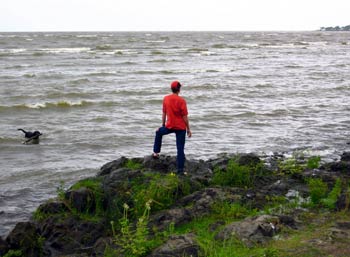 Photo: Lake Nicaragua
Photo: Lake Nicaragua
That done, the officer focused his attention on Rus and the multa (remember that word?) that he would have to pay for the infraction. Rus said, "Infraction?, it's just an accident, not a crime. We've paid for the damage we caused, and we just want to continue our trip". But this was a serious matter, the officer said, and asked for his license. This cop was a pretty nasty-looking guy, with cold eyes, and he was also smart-- he could tell right away the license was a laminated color copy. He demanded the real one. Rus nearly gave it to him, but didn't like how this was shaping up and changed his mind, presenting his International License instead. He said it was a legal license for foreigners in Nicaragua (which he hoped was true). The officer insisted on the original California license, Rus refused, and the officer said, "OK, we're going to the station." Rus said fine, let's go. Both of them were pretty mad by then. We got back into our rig to follow him to the station, but he didn't move. Instead he got out his ticket book, and walked to the rear to take down our plate number. We gave him a few minutes, and both cooled down a little, then Rus got out and walked around to see if there were any moves left on the board. The officer put away the ticket book he'd been pretending to write in, handed back Rus' fake license, said to be careful on these narrow streets and we could go. Which we did, accompanied by a very loud and frightening popping sound. As we pulled out we'd scraped the side of our rig on a concrete power pole, snapping the end cover off our awning! That was a hairy one, and we were both rattled.
 Tobacco barns near Esteli
Tobacco barns near Esteli
Esteli and the Parque de Ciencia
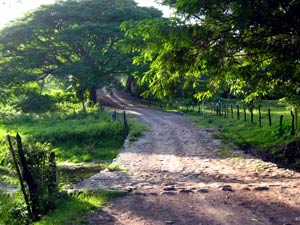 By late afternoon, we made it to the city of Esteli, famous as a Sandanista center and therefore the scene of terrible fighting and reprisals during the revolution. We saw a sign that said Touricentro, and followed the road down the worst 1.5km of rocks, ruts and serious mudholes we've seen yet. Who the hell would put a touring center down a road like this? But there was plenty of traffic on it, and a cab driver confirmed not only that it did exist, but we were on the right road. Pretty soon we arrived at Estelimar, a lovely complex of buildings generously spread out over a large plot of land set against a hillside, with a spring running through the property into a stone-lined pool. We were directed by a man lounging against the largest building to go upstairs and talk to the manager. Kathleen went to see him, but he was on the phone and motioned for her to wait. He stayed on the phone a good while, and we imagined we were at the mercy of a self-important administrator, who loved talking on the phone as much as making people wait. We couldn't have been more wrong.
By late afternoon, we made it to the city of Esteli, famous as a Sandanista center and therefore the scene of terrible fighting and reprisals during the revolution. We saw a sign that said Touricentro, and followed the road down the worst 1.5km of rocks, ruts and serious mudholes we've seen yet. Who the hell would put a touring center down a road like this? But there was plenty of traffic on it, and a cab driver confirmed not only that it did exist, but we were on the right road. Pretty soon we arrived at Estelimar, a lovely complex of buildings generously spread out over a large plot of land set against a hillside, with a spring running through the property into a stone-lined pool. We were directed by a man lounging against the largest building to go upstairs and talk to the manager. Kathleen went to see him, but he was on the phone and motioned for her to wait. He stayed on the phone a good while, and we imagined we were at the mercy of a self-important administrator, who loved talking on the phone as much as making people wait. We couldn't have been more wrong.
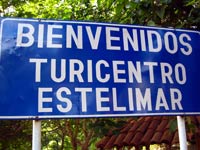 Soon enough, Eduardo Herrera came down to meet us, immediately gave us permission to park for the night and assured us it was secure. Then he gave us a tour of the property. Eduardo is the director of the Parque de Ciencia en Nicaragua, the Nicaragua Science Park, open to primary and secondary school kids who attend from all over the country on weekends. The Parque de Ciencia uses the facilities of the Estelimar Touricentro, and with thousands of kids coming through every year, it pretty much dominates the facility. Funded two years ago with a private grant from Linus Torvalds, the Finn who developed the Linux operating system, this science park was created to help kids explore technology by giving them hands-on experience in practical applications of scientific principles. There's a computer lab and graphic design school, metal sculptures of large animals with moving parts powered by solar, steam and hydraulic power, lots of other hands-on exhibits, and walls lined with short bios of real people who invented real things that people use every day. They have teachers, some credentialed and others who are professionals working in a technical field. Here, though, they're all called "guides", as it's a park, not a school. Since it's located in a touring center (which in Latin America is a recreational center, not a place for tourists) the kids also get the use of the pools, dormitories and cafeteria. They pay for their food, but everything else is covered.
Soon enough, Eduardo Herrera came down to meet us, immediately gave us permission to park for the night and assured us it was secure. Then he gave us a tour of the property. Eduardo is the director of the Parque de Ciencia en Nicaragua, the Nicaragua Science Park, open to primary and secondary school kids who attend from all over the country on weekends. The Parque de Ciencia uses the facilities of the Estelimar Touricentro, and with thousands of kids coming through every year, it pretty much dominates the facility. Funded two years ago with a private grant from Linus Torvalds, the Finn who developed the Linux operating system, this science park was created to help kids explore technology by giving them hands-on experience in practical applications of scientific principles. There's a computer lab and graphic design school, metal sculptures of large animals with moving parts powered by solar, steam and hydraulic power, lots of other hands-on exhibits, and walls lined with short bios of real people who invented real things that people use every day. They have teachers, some credentialed and others who are professionals working in a technical field. Here, though, they're all called "guides", as it's a park, not a school. Since it's located in a touring center (which in Latin America is a recreational center, not a place for tourists) the kids also get the use of the pools, dormitories and cafeteria. They pay for their food, but everything else is covered.
As Eduardo walked us through the Parque, it was inspiring to see someone so excited about what he was doing. We also met Abenar, the program director, who shared the same passion. We donated a new American soccer ball and a bunch of pens and promised to stay in touch. The kids were in need of electronics to disassemble and study, and we have plenty. Perhaps we can send some down with one of the buses that travel to our town's sister city of Camoapa, a couple of hours away. Eduardo and Abenar went home to their families for the night and we went home to our rig, grateful not only for their generosity, but also that we hadn't come on the weekend with a couple of hundred kids! To learn more or contact them their website is www.asdenic.org/parque/index.html

View of Esteli from the Parque de Ciencia
Honduras, Again
We left Esteli early, made the border about 9:30 am. We paid the $2 "tax" to leave Nicaragua and surrendered our vehicle permit, as usual. While Kathleen was gathering papers from the truck a boy approached her, begging. She said she didn't believe in giving money to kids for nothing but asked him if he was hungry. He nodded. So she went into the rig for some crackers and cheese snacks, throwing a big handful of mamon into the bag. When the boy saw the fruit his face lit up and he began to eat it immediately. Kathleen returned to the rig and a few seconds later some men knocked on the open window and shouted to her, "Mamon, mamon, do you have enough for us to have some too?" Kathleen laughed and nodded, sure, knowing she and Rus could never eat the whole bunch. As the men stepped up to get the fruit a young girl selling bags of homemade candy shyly got in line too, asking only with her eyes, and saying thank you with her smile. Everyone here knows mamon grows in Costa Rica but apparently not in northern Nicaragua where it is quite a treat!
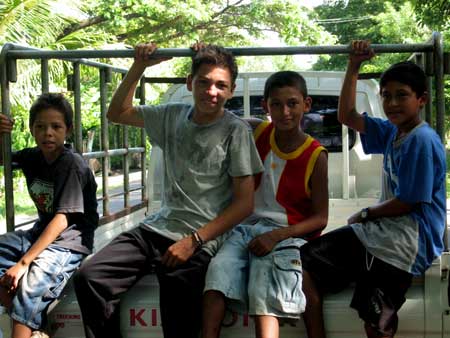 When we parked in Honduras to take care of the entry process, Rus let Ziggy out of the rig to run around. Kathleen was tense because we had planned to hide her and avoid the trouble we'd had before regarding dogs in Honduras. The woman at Aduana, the vehicle permit office, asked Kathleen for Ziggy's permit. Kathleen told her that the man had already taken care of it with Rus (who was outside showing the VIN to the inspector), but that she'd go get the papers if she needed to see them again. The woman just shrugged, as if to say, no that's OK. So we paid our $29 for the vehicle permit and $6 for Migracion and headed through the green hills toward Choluteca, where we'd stayed a few weeks before.
When we parked in Honduras to take care of the entry process, Rus let Ziggy out of the rig to run around. Kathleen was tense because we had planned to hide her and avoid the trouble we'd had before regarding dogs in Honduras. The woman at Aduana, the vehicle permit office, asked Kathleen for Ziggy's permit. Kathleen told her that the man had already taken care of it with Rus (who was outside showing the VIN to the inspector), but that she'd go get the papers if she needed to see them again. The woman just shrugged, as if to say, no that's OK. So we paid our $29 for the vehicle permit and $6 for Migracion and headed through the green hills toward Choluteca, where we'd stayed a few weeks before.
Fueling up at a station outside of town, we asked the attendants if they knew of a glass shop to get our broken window replaced. There was one less than a hundred yards away. We drove over, the guys got right to work, and an hour later we were back on the road with a new window. Cost: 50 Lempira, or $2.78. How can they make any money like that? We think people in Honduras should charge more for their services, at least to gringos. Our first time through, we had a tire changed in Trujillo. The boy worked on it over an hour and we were charged less than $2.00, and this was after Rus told the owner it was taking longer than expected, and wouldn't hold him to his original quote of $1.50!
 Though we'd made less than a hundred miles, we stopped in Choluteca for the night at the Hotel Gualiqueme, where we'd parked before. At the pool we had fun playing with 3 little kids, two girls and a boy, who were waiting for their swimming lessons. Rus and the kids invented a game they named "Basura!" (garbage), in which Rus would hurl them through the air into the pool, like tossing a garbage bag into a truck. They couldn't get enough of it, but he was glad their parents weren't there to see a foreigner throwing their kids around and hollering "Basura!"
Though we'd made less than a hundred miles, we stopped in Choluteca for the night at the Hotel Gualiqueme, where we'd parked before. At the pool we had fun playing with 3 little kids, two girls and a boy, who were waiting for their swimming lessons. Rus and the kids invented a game they named "Basura!" (garbage), in which Rus would hurl them through the air into the pool, like tossing a garbage bag into a truck. They couldn't get enough of it, but he was glad their parents weren't there to see a foreigner throwing their kids around and hollering "Basura!"
Photo above: Honduran men wash their oxen in the river while women wash clothes in the shade at right
From Nicaragua to El Salvador there's just a short stretch of Honduras to go through, but it was such a pleasure to be back, even for a day, in this country we grew to love so much. Honduras is a beautiful land where we met many friendly, generous people.
El Salvador
 Next day, arriving by late morning at the border town of El Amatillo, we parked and shook off the small crowd of transitos waiting for us by stopping to eat at a sidewalk comedor before crossing into El Salvador. The woman there was serving delicious pupusas (thin masa cakes filled with cheese) and a wonderfully seasoned chicken stew with fried yucca and cortido de repollo (a spicy chopped cabbage). It was one of the best meals we've had in Latin America, and set us back $1.33. Photo: eating at the Honduras side of the border
Next day, arriving by late morning at the border town of El Amatillo, we parked and shook off the small crowd of transitos waiting for us by stopping to eat at a sidewalk comedor before crossing into El Salvador. The woman there was serving delicious pupusas (thin masa cakes filled with cheese) and a wonderfully seasoned chicken stew with fried yucca and cortido de repollo (a spicy chopped cabbage). It was one of the best meals we've had in Latin America, and set us back $1.33. Photo: eating at the Honduras side of the border
We got our passports stamped out of Honduras, then hired a boy with a bike taxi to take us across the bridge to the El Salvador side of the river. In El Salvador, they have the most helpful border officials we've ever met. People who had nothing to do with the offices we were looking for went out of their way to help us. At the Aduana, where we got our vehicle permits, we suddenly realized the guy who'd been taking so much care helping us with our paperwork wasn't even with Customs, but was just a vigilante, a private security guard. At the end, we offered him a tip, but he politely refused. This was a new experience for us; we appreciated it immensely and hope others will, too. We left Ziggy in the rig and didn't breathe a word about her, so she was an undocumented immigrant in El Salvador.
El Espino
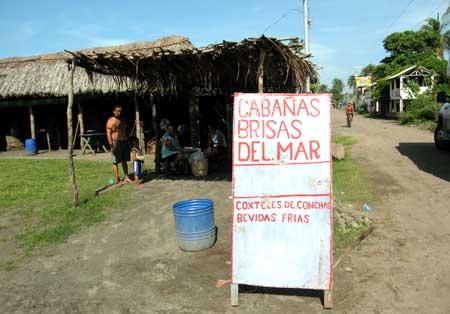 According to our little out-of-print guidebook, On Your Own in El Salvador, the best stretch of undeveloped beach in the country is El Espino, and well worth the rough drive. The narrow road we turned off onto was actually paved, not dirt like the book said, and we were encouraged. A few miles in, though, everything came to a halt. Cars and trucks were backed up for some ways ahead, just creeping along, and we couldn't see what the problem was. The vehicles behind us pulled out and passed, but we were larger and not so brazen, so we stayed in line. Though we crept slowly ahead, we never seemed to get any closer to the accident or whatever was holding things up. After about 20 minutes, the road straightened and we could see a crowd of people walking at the head of the line of cars. We'd been bringing up the rear of a funeral procession! Photo: Dozens of palapa edged yards like this dot the beach, inviting people to hang a hammock and relax. We chose to make camp in the one above.
According to our little out-of-print guidebook, On Your Own in El Salvador, the best stretch of undeveloped beach in the country is El Espino, and well worth the rough drive. The narrow road we turned off onto was actually paved, not dirt like the book said, and we were encouraged. A few miles in, though, everything came to a halt. Cars and trucks were backed up for some ways ahead, just creeping along, and we couldn't see what the problem was. The vehicles behind us pulled out and passed, but we were larger and not so brazen, so we stayed in line. Though we crept slowly ahead, we never seemed to get any closer to the accident or whatever was holding things up. After about 20 minutes, the road straightened and we could see a crowd of people walking at the head of the line of cars. We'd been bringing up the rear of a funeral procession! Photo: Dozens of palapa edged yards like this dot the beach, inviting people to hang a hammock and relax. We chose to make camp in the one above.
Arriving at last in El Espino, a tiny community arranged along a dirt lane paralleling a beautiful black sand beach, we cruised slowly by, looking for a place to camp for the night. We appeared to be the only ones in El Espino who didn't live there. All the beachfront comedors and palapas were closed and deserted, though people were visiting and relaxing outside their homes and waved to us as we passed. We pulled up next to a very modest home with a couple of palapas for rent and a yard big enough for us to park, Brisas del Mar. The owners, Herman and Ana Marie, greeted us and were happy to have us stay the night, thereby capturing 100% of the tourism dollars for El Espino that day, or maybe that month. We negotiated a fee that worked for everyone, maneuvered into their yard, got on our swimsuits and dove into the Pacific Ocean where it met "the best beach in El Salvador". The water was perfect, that inviting temperature you can stay in forever, with a surf that was playful without beating you up.
 The three of us were enjoying this immensely when a big wave hit Kathleen and she yelled," I've lost my key!" She wore her entry key around her wrist on a spiral band, and the powerful wave swept it right off. Rus didn't carry a key when they went swimming together, so we were good and locked out. But there was no use going back right away: we had nothing else with us to lose, so we swam a few minutes longer and hatched our plan for breaking into the rig. Herman gave us some help and Anna Marie and the kids looked on, contributing moral support. For security reasons we won't say how we did it here, but it was a little scary how easy it was, and without breaking anything, either! Photo:El Espino at sunset
The three of us were enjoying this immensely when a big wave hit Kathleen and she yelled," I've lost my key!" She wore her entry key around her wrist on a spiral band, and the powerful wave swept it right off. Rus didn't carry a key when they went swimming together, so we were good and locked out. But there was no use going back right away: we had nothing else with us to lose, so we swam a few minutes longer and hatched our plan for breaking into the rig. Herman gave us some help and Anna Marie and the kids looked on, contributing moral support. For security reasons we won't say how we did it here, but it was a little scary how easy it was, and without breaking anything, either! Photo:El Espino at sunset
The ocean has slowly been nibbling away at El Espino. Herman told us that 40 years ago the tide line was 60 meters further out, and "El Mitch" (Hurricane Mitch) accelerated the loss considerably. In winter, which is now, he has to shovel sand every day from the beach up to his property to replenish what the tides claimed the day before. It looked like a losing battle, but at least it was buying him time. All along the beach, the posts of abandoned palapas were awash at high tide. The owners of lots on the other side of the street were probably eagerly biding their time until the beachfront property was theirs.
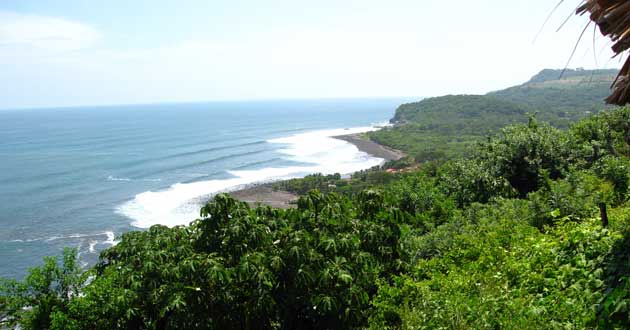
Views of the coastline along the Littoral Highway are spectacular
Parque Nacional Cerro Verde
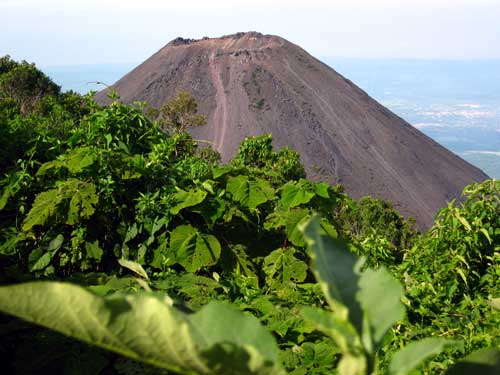 In the morning, with our spare key on a florescent orange floating keychain in a secure pocket, we took another swim before saying good-bye to our hosts, and drove off too see the other end of El Salvador's geographical spectrum. The Parque Nacional Cerro Verde is one of this small country's jewels, high in the cloud forest and packed with as many volcanoes as it's possible to fit in one place. The park headquarters complex, originally a private enterprise at the rim of the Volcan Cerro Verde, long-extinct and now covered with virgin forest, was built to give visitors a close-up view of the erupting Volcan Izalco (pictured above) but by the time it was finished in 1958 the volcano was pretty much done too, and the El Salvadoran government eventually took it over as the park's visitors center. We climbed thousands of feet through coffee farms and cedar forest, which opened occasionally to panoramas of the huge Lago de Coatepeque below. The lake fills the crater of a giant extinct volcano, and is as beautiful as Lago Atitlan in Guatemala which gets all the glory. We arrived at the gates of the visitors center and were met by Ranger Jorge, who collected our entry fee, said we could park anywhere we liked, and gave us an orientation of the trails nearby. He'd brought his camera when he saw us coming and asked us to take a photo of him next to our rig; we don't think they get many gringos, or rvs either. Unfortunately, Ziggy had to stay in the truck because dogs are not allowed in the park. After a hike around the crater rim, returning just as an afternoon shower began, we settled in for a peaceful evening and a long sleep, grateful for the cool air and also for no roosters. Ours was the only vehicle in the place.
In the morning, with our spare key on a florescent orange floating keychain in a secure pocket, we took another swim before saying good-bye to our hosts, and drove off too see the other end of El Salvador's geographical spectrum. The Parque Nacional Cerro Verde is one of this small country's jewels, high in the cloud forest and packed with as many volcanoes as it's possible to fit in one place. The park headquarters complex, originally a private enterprise at the rim of the Volcan Cerro Verde, long-extinct and now covered with virgin forest, was built to give visitors a close-up view of the erupting Volcan Izalco (pictured above) but by the time it was finished in 1958 the volcano was pretty much done too, and the El Salvadoran government eventually took it over as the park's visitors center. We climbed thousands of feet through coffee farms and cedar forest, which opened occasionally to panoramas of the huge Lago de Coatepeque below. The lake fills the crater of a giant extinct volcano, and is as beautiful as Lago Atitlan in Guatemala which gets all the glory. We arrived at the gates of the visitors center and were met by Ranger Jorge, who collected our entry fee, said we could park anywhere we liked, and gave us an orientation of the trails nearby. He'd brought his camera when he saw us coming and asked us to take a photo of him next to our rig; we don't think they get many gringos, or rvs either. Unfortunately, Ziggy had to stay in the truck because dogs are not allowed in the park. After a hike around the crater rim, returning just as an afternoon shower began, we settled in for a peaceful evening and a long sleep, grateful for the cool air and also for no roosters. Ours was the only vehicle in the place.
 Early next morning, we took in the view before us. The Volcan Izalco, mostly shrouded in clouds the day before, was now completely visible, very big and startlingly close. At our elevation, we could look into its crater, where just one fumerol emitted a small wisp of steam. But we're on different timetables, volcanoes and people; generations of us come and go while a volcano takes a quick catnap. Photo: Cerro Verde was a lovely place to camp, Volcan Izalco is hidden behind the trees to the left of our rig
Early next morning, we took in the view before us. The Volcan Izalco, mostly shrouded in clouds the day before, was now completely visible, very big and startlingly close. At our elevation, we could look into its crater, where just one fumerol emitted a small wisp of steam. But we're on different timetables, volcanoes and people; generations of us come and go while a volcano takes a quick catnap. Photo: Cerro Verde was a lovely place to camp, Volcan Izalco is hidden behind the trees to the left of our rig
Below: Four views of the stunning Lago de Coatepeque

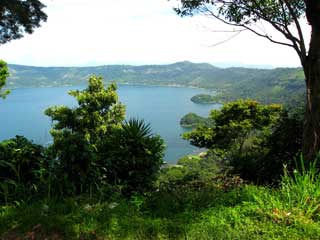 After a short walk to the mirador for a more panoramic view, we made ready to leave, stopping back at the entrance to get water. A small group of young people was gathered there; we thought they might be students on a field trip, but it turned out they were guides, waiting for the day's visitors to arrive. As we filled our tank, we opened the door to let Ziggy out to stretch, and the guides nearest by scattered, one actually protecting his testicles as he made for safety, to the great amusement of the others. Ziggy may never again get the level of respect she's enjoying here in Central America. Stopping at the security gate a ways down from the entrance, Ranger Jorge came out to wish us a safe trip and presented us with an autographed copy of a beautiful color poster of Cerro Verde.
After a short walk to the mirador for a more panoramic view, we made ready to leave, stopping back at the entrance to get water. A small group of young people was gathered there; we thought they might be students on a field trip, but it turned out they were guides, waiting for the day's visitors to arrive. As we filled our tank, we opened the door to let Ziggy out to stretch, and the guides nearest by scattered, one actually protecting his testicles as he made for safety, to the great amusement of the others. Ziggy may never again get the level of respect she's enjoying here in Central America. Stopping at the security gate a ways down from the entrance, Ranger Jorge came out to wish us a safe trip and presented us with an autographed copy of a beautiful color poster of Cerro Verde.
We had been warned about the dangers of theft and violence in the poor country of El Salvador, had heard stories both positive and negative from other travelers there. And although we had bypassed this tiny country on our way down, we were glad we got to know it a little on our return. From the border vigilante who refused a tip to the friendly, energetic young women and men who worked as guides on the Volcano, to people that simply crossed our paths, we found most El Salvadorans to be open, interested in us, and very giving. The physical beauty of El Salvador complements the graciousness of its people; our visit was short and we promised ourselves to stay longer next time.
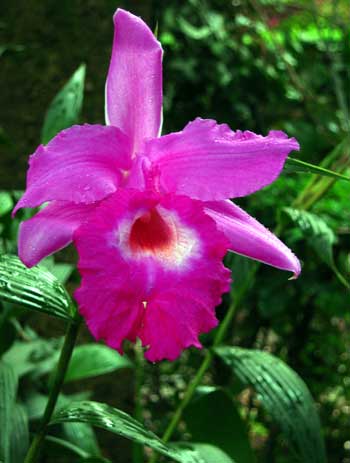
|

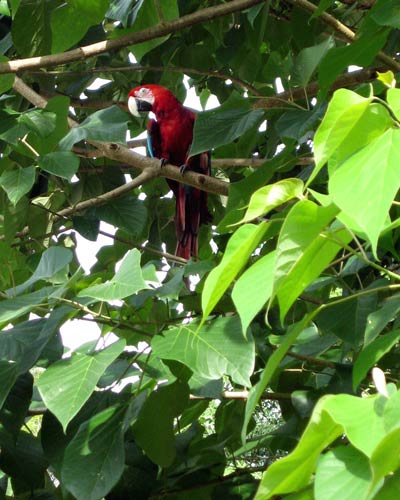 dawdling. Jamie and Larissa's wedding date was September 17th and we wanted to be home at least a week before to help with last minute details. Our drive through Panama took one day. We stopped in David to use the wifi we found in a modern-looking mall parking lot. The vistas of green mountains, valleys, and croplands again dazzled us and the crossing into Costa Rica was easy and surprisingly efficient. We headed straight for our $3 Hotel Gran Impala in Rio Claro and walked along the wide central street as darkness fell, looking in vain for our malaria medicine, Chloroquin, and buying chicken off a street-side grill.
dawdling. Jamie and Larissa's wedding date was September 17th and we wanted to be home at least a week before to help with last minute details. Our drive through Panama took one day. We stopped in David to use the wifi we found in a modern-looking mall parking lot. The vistas of green mountains, valleys, and croplands again dazzled us and the crossing into Costa Rica was easy and surprisingly efficient. We headed straight for our $3 Hotel Gran Impala in Rio Claro and walked along the wide central street as darkness fell, looking in vain for our malaria medicine, Chloroquin, and buying chicken off a street-side grill. 
